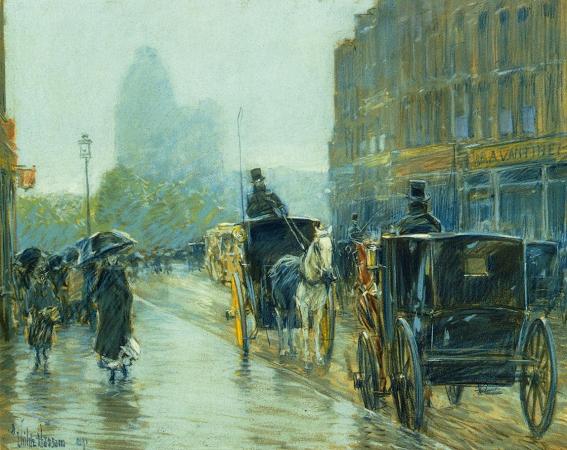Childe Hassam (1859 - 1935). Frederick Childe Hassam was an American Impressionist painter, noted for his urban and coastal scenes. Along with Mary Cassatt and John Henry Twachtman, Hassam was instrumental in promulgating Impressionism to American collectors, dealers, and museums. He produced over 3,000 paintings, oils, watercolors, etchings, and lithographs over the course of his career, and was an influential American artist of the early 20th century. Hassam was known to all as Childe, a name taken from an uncle. Hassam was born in the family home on Olney Street on Meeting House Hill in the Dorchester neighborhood of Boston, on October 17, 1859. His father, Frederick Fitch Hassam, was a moderately successful cutlery businessman with a large collection of art and antiques. He descended from a long line of New Englanders. His mother, Rosa Delia Hawthorne, a native of Maine, shared an ancestor with American novelist Nathaniel Hawthorne. His father claimed descent from a seventeenth-century English immigrant whose name, Horsham, had been corrupted over time to Hassam. With his dark complexion and heavily lidded eyes, many took Childe Hassam to be of Middle Eastern descent, speculation which he enjoyed stoking. In the mid-1880s, he took to painting an Islamic-appearing crescent moon next to his signature, and he adopted the nickname Muley, invoking Muley Abul Hassan, a fifteenth-century ruler of Granada whose life was fictionalized in Washington Irving's novel Tales of the Alhambra. Hassam demonstrated an interest in art early. He had his first lessons in drawing and watercolor while attending The Mather School, but his parents took little notice of his nascent talent. As a child, Hassam excelled at boxing and swimming at Dorchester High School. A disastrous fire in November 1872 wiped out much of Boston's commercial district, including his father's business. Hassam left high school after two years, and by 1880 his family had moved to nearby Hyde Park. Despite his uncle's offer to pay for a Harvard education, Hassam preferred to help support his family by working. His father arranged a job in the accounting department of publisher Little, Brown & Company. During that time, Hassam studied the art of wood engraving and found employment with engraver George Johnson. He quickly proved an adept draughtsman and produced designs for commercial engravings such as letterheads and newspapers. Beginning to paint artistically, his preferred medium was watercolor, mostly outdoor studies, and around 1879 began creating his earliest oils. In 1882, Hassam became a free-lance illustrator, and established his first studio. He specialized in illustrating children's stories for magazines such as Harper's Weekly, Scribner's Monthly, and The Century. He continued to develop his technique while attending drawing classes at the Lowell Institute and at the Boston Art Club, where he took life painting classes. By 1883, Hassam had exhibited watercolors in his first solo exhibition at the Williams and Everett Gallery in Boston. The following year, his friend Celia Thaxter convinced him to drop his first name and thereafter he was known as Childe Hassam. He also began to add a crescent symbol in front of his signature, the meaning of which remains speculative, possibly an allusion to his penchant for inferring Middle Eastern or Turkish origins. Having had relatively little formal art training, Hassam was advised by his friend and fellow Boston Art Club member Edmund H. Garrett to join him on a two-month study trip to Europe during the summer of 1883. They traveled throughout the United Kingdom, the Netherlands, France, Italy, Switzerland, and Spain, studying the Old Masters together and creating watercolors of the European countryside. Hassam was particularly impressed with the watercolors of J. M. W. Turner. Sixty-seven of the watercolors that Hassam painted on this trip formed the basis of his second exhibition in 1884. During this period, Hassam taught at the Cowles Art School. He also joined the Paint and Clay Club, expanding his contacts in the art community, which included prominent critics and the readiest and smartest of our younger generation of artists, illustrators, sculptors, and decorators, the nearest thing to Bohemia that Boston can boast. Friends found him to be energetic, robust, outgoing, and unassuming, capable of self-mockery and considerate acts, but he could be argumentative and wickedly witty against those in the art community who opposed him. Hassam was particularly influenced by the circle of William Morris Hunt, who like the great French landscape painter Jean-Baptiste-Camille Corot, emphasized the Barbizon tradition of working directly from nature.
more...













